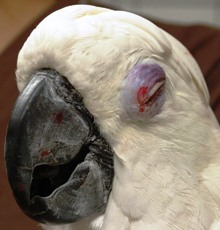Feather Loss and Circovirus Infection
Psittacine Circovirus (Psittacine Circoviral Disease or PCD) is a viral infection that is spread easily through feathers and feces. It affects parrots and other psittacine birds and causes the loss of feathers, usually on the chest or thighs. In some birds, such as Eclectus, king parrots, and lorikeets, the early signs may be a change in color, with affected feathers showing streaks of white, yellow, or black. Cockatoos and parrots often show loss of the powder down first since powder down is replaced often; it may take a few molts to see changes in coverlets and other feathers. With time, the feather loss involves the wings and the rest of the body. Early in the infection, feathers may grow in to replace the missing ones. These regrown feathers are abnormally-shaped and easily break at their bases. As the infection progresses, new feathers do not grow and old ones are not replaced. Infected birds may show excessive abnormal growth of the beak and toenails. The beak and nails curl in unusual shapes. The beak and nails may flake, crack, and develop soft areas that are weak and may break. Yeast and other infections may develop in cracks of the beak and nails. Beaks can become so severely affected that the bird can no longer feed on its own.





 Birds can injure themselves quite easily in the typical household. It is important to "bird proof" your home so that you lessen the chance of serious accidents.
Birds can injure themselves quite easily in the typical household. It is important to "bird proof" your home so that you lessen the chance of serious accidents.